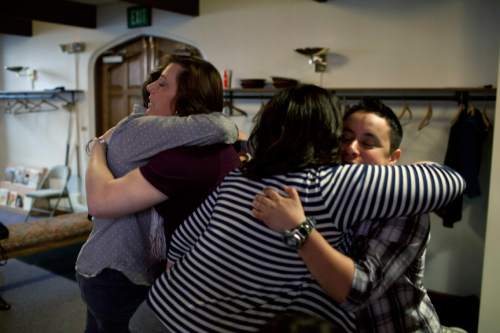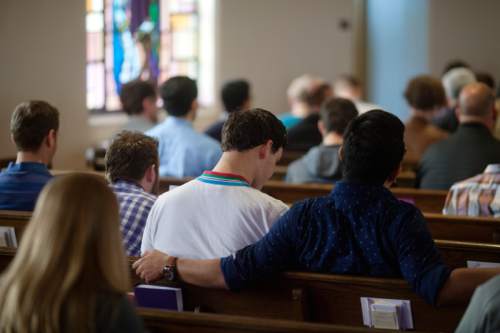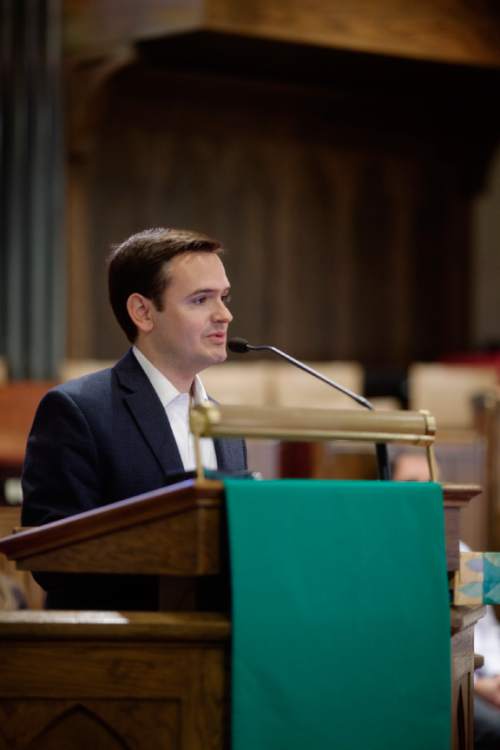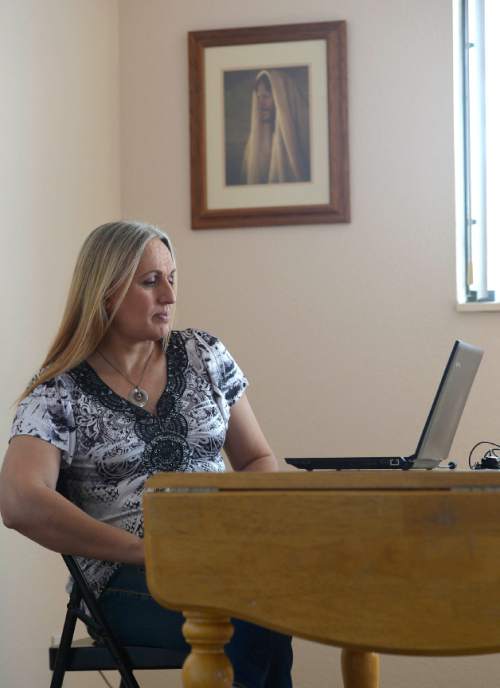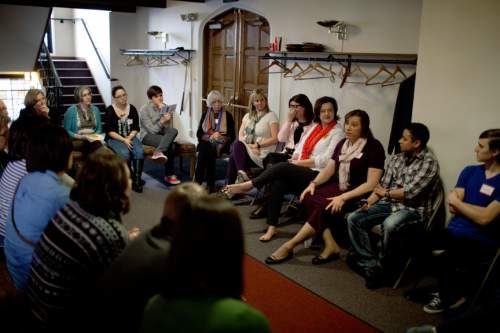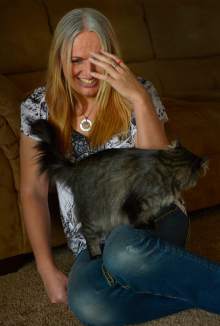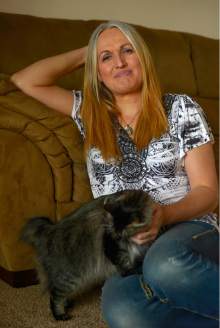This is an archived article that was published on sltrib.com in 2015, and information in the article may be outdated. It is provided only for personal research purposes and may not be reprinted.
Some Mormons left church in tears, distraught at the anti-LGBT sentiments tossed around by their fellow believers. Others emerged exuberant, surprised by the kindness shown toward their gay brothers and sisters.
Either way, at least they were talking — and in a religious setting — about an often uncomfortable, even taboo, topic: same-sex marriage.
Just days after the U.S. Supreme Court legalized the practice in all 50 states, the LDS Church sent its lay leaders in the United States and Canada an unusual request:
Read a letter from Mormonism's top leaders to all members, reiterating the Utah-based faith's steadfast support of "traditional" marriage and other stances on lesbian, gay, bisexual and transgender rights, so the instructions said, but do it in another meeting than the main sacrament (worship) service and possibly use provided materials to lead a discussion about homosexuality.
This, the governing LDS First Presidency and Quorum of the Twelve Apostles wrote, should happen on either July 5 or 12.
In other words, save for the edict that the entire statement be read, officials with The Church of Jesus Christ of Latter-day Saints did not dictate how or when the materials should be discussed — an open-ended, individualized approach that is largely unprecedented in the LDS Church on such a major topic.
Mormon bishops (lay leaders of congregations known as "wards") were free to choose the day of this action (last Sunday or this Sunday), which elements to highlight and what tone to set for the conversation.
This ensured the experience would vary dramatically from region to region, ward to ward, bishop to bishop.
And so it did last Sunday, according to reports from the Bay Area to Boston, Brooklyn, Baltimore and Boise, from Denver to Detroit, from Albuquerque to Atlanta.
Before the Sabbath ended, members were sharing their experiences on social media, both positive and negative.
"In EQ [elders quorum]," Joseph Stuart tweeted, "we were encouraged to prepare ourselves for the apocalypse after an unelected body trampled the Constitution."
It was "a train wreck," filled with distrust and fear and 'us' verses 'them' comments," wrote a Lehi Latter-day Saint. "With the exception of one lovely woman, every comment and response was a reflection of perceived victimhood, how our religious freedoms are being attacked, and the persecution our church is under. There was almost nothing about Christlike love or compassion for those who are different than us. It was awful."
Yet another Lehi member, a mother who works with the faith's Young Women (teens ages 12-17) in a different ward noted that "the bishopric member reading it prefaced it by talking about his friend who is gay and how much he loves that friend. Then the YW had its regular lesson and the topic came up and they were basically counseled to be good to everyone."
In Bloomington, Ill., according to an attendee, members asked questions such as "What if my friend invites me to their gay wedding?" or "What if someone who is gay wants to come to church?"
The bishop replied, "Are they your friend? Tell them we'd love to have them."
—
'Get used to it' • Some LDS leaders chose to read the letter to their members immediately after the close of sacrament meeting. Some spoke only to adults. Some added their own words. Some chose to forgo discussion altogether, urging members to study the letter for themselves and only come to their leaders if they had questions.
"We had a special meeting during the third hour with all of the men and women age 12 and up. The bishop read it and asked for people's thoughts and impressions. He then asked if there were any questions," wrote Steve Densley of American Fork. "The tone was respectful. A number of people noted the importance of supporting the church in its position on the law of chastity, while at the same time being careful to extend love, fellowship and respect to those with differing viewpoints."
The letter itself counseled members to "love and treat all people with kindness and civility — even when we disagree."
"We affirm that those who avail themselves of laws or court rulings authorizing same‐sex marriage should not be treated disrespectfully," it said. "Indeed, the church has advocated for rights of same‐sex couples in matters of hospitalization and medical care, fair housing and employment, and probate, so long as these do not infringe on the integrity of the traditional family or the constitutional rights of churches."
In some congregations, it was less a question of content than tone.
A man in central California wrote: "Because of the manner of simply reading [the letter] verbatim, it had the same effect as telling us the [heating and air-conditioning] systems were going out, so the building would not be available next week."
Steve Rotterdam, who attends a Manhattan LDS ward, noted a vigorous discussion among the men in the ward's high priests' group, including a number of summer visitors.
"Pretty much everyone agreed that we are poorer as a ward family," Rotterdam wrote, "when we exclude and/or marginalize members of our community for any reason."
He then quipped: "Finally, no one was concerned about the possibility of same-sex couples wanting to have ceremonies or celebrations held on the grounds of the church, because, honestly, have you seen our gym?"
In Rochester, N.Y., the bishop was "quite upbeat and even friendly in his approach," wrote Jerry Argetsinger, a gay Mormon who directed the Hill Cumorah Pageant for many years. "He said to the congregation, 'Regardless of what you think about the SCOTUS decision, it is here to stay. So get used to it.' "
—
Keeping them safe • For some Mormon bishops, it was a routine assignment; to others, it proved a challenging or unsettling task.
Several reached out to Mitch Mayne, a gay Mormon in San Francisco who has served as an LDS executive secretary and who remains fully involved in his LDS ward.
Mayne put together the following three-part strategy for these Mormon leaders:
• Direct members to the church's own website, mormonsandgays.org, which emphasizes that being gay is not a choice and that being gay is not a sin, only acting on it is.
• Describe the dangers of suicide to gays who are rejected by their families and the importance of keeping these young Mormons safe.
• Remind them that the church allows for divergent viewpoints on marriage equality.
"A lot of what we do when we stumble over ourselves turns out to be the Lord working through us as imperfect beings," Mayne said in an interview. "This has burst our bubble of denial that being LGBT is something that happens to someone else somewhere else. When we start to become more informed, we realize there's really no them or us, there's only us."
When Mayne began his activism after 2008, he focused mostly on LGBT members and their families. Now, he is getting calls from LDS bishops, high councilors and stake presidents.
"They reach out in confidence," he said, "to try and understand this deeply."
And that, Mayne added, "is a very, very good thing."
Indeed, some bishops saw the proposed discussion around the church's letter a great opportunity to tamp down the verbal polarities.
"I will read it during a combined third hour on Sunday [July 12], followed by a discussion led by my wife and me," said Richard Ostler, an LDS singles ward bishop in Salt Lake City. "Primary focus will be teaching the [traditional marriage] doctrine of the church's 'Proclamation on the Family' and the compassionate principles of 'Love for All and Agency.' Don't want the meeting to turn into an 'us' versus 'them' and will work to reduce the fear comments such as 'same-sex temple marriages are next.' "
—
'Love is enough' • At least a couple of gay and transgender Mormons reported extraordinarily positive exchanges in their wards.
Nick Einbender, a gay member in Honolulu, said his bishop read the letter to all adults and youths, then opened it up to discussion.
The first comment came from Einbender's partner, Spencer Mickelson, who explained that "he has done everything his church leaders have suggested throughout his life to overcome and deal with being gay short of brainwashing himself, and that over a period of time, through prayer and personal revelation following the promptings of the Spirit, has realized that being gay is part of his mission here on Earth."
Mickelson went on to share his faith in the Mormon gospel, Einbender recounted in an email, and many in the room were quietly weeping and nodding in agreement.
Einbender then addressed the group.
"I bore my testimony of the motivating power of Christ's teachings and pleaded with the members to love, embrace, welcome and support a gay son, daughter, family member or friend, even without having the answers to reconcile their own beliefs with the situation," he wrote. "That love is enough. I reminded them that a seemingly insignificant act of kindness and love by them toward other members of the church may be an answer to a prayer, may be a miracle, may save a life."
After the session, members surrounded the couple as if they were "in a wedding lineup," Einbender said. "They ranged from 90-plus-year-olds to young teenagers all with smiles, with tears, and an outpouring of love that one would had to have been present to understand. It was truly humbling not only to receive such love, but also to be used as tools of understanding in God's hands."
—
'Truly home' • In Salt Lake City, transgender Mormon Sara Jade Woodhouse, had a similar experience. After the bishop read the letter, she said, "placing it to the side, he wept."
The Mormon leader told the congregation "he didn't understand why things happen the way they did … that God still has yet to reveal many things."
The man then said two of his children are gay and he looked forward to the day "when his gay child could feel welcome to bring their partners to church with them and feel the love surround them."
She sat in the back of the room, quietly crying, she wrote on her blog. "I was truly home."
The LDS Church's letter was unbending in its denunciation of same-sex marriage.
"Marriage between a man and a woman was instituted by God and is central to his plan for his children and for the well‐being of society," it declared. " … Changes in the civil law do not, indeed cannot, change the moral law that God has established. God expects us to uphold and keep his commandments regardless of divergent opinions or trends in society."
Yet, in a surprising way, the document may have opened up church conversations as never before.
"Maybe this is one way God works," wrote Jody England Hansen, "to take some fearful, divisive retrenchment letter, and turn it into a time where more people than ever are needing to really look at each other as brothers and sisters."
Change is never easy, Mayne added. "Life never hands us a challenge that doesn't carry with it an amazing opportunity."
When Mormon families in small towns such as Rexburg, Idaho, are talking at church about loving gays, he said, "that is a remarkable step forward."
— Reporter Amy McDonald contributed to this report.
pstack@sltrib.com Twitter: @religiongal


